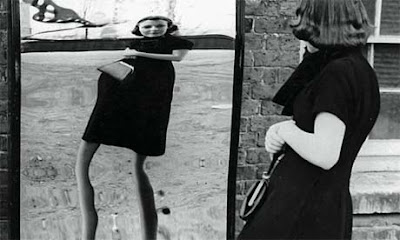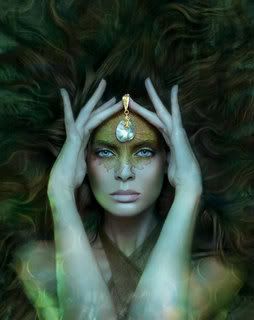.jpg) If you asked me how I knew that the initially named "Ormonde" would be one of my favourites in the Ormonde Jayne line, then I'd tell you that having sampled the lot of them, its languid decay and bittersweet melancholy stood out in my mind for weeks to come and all of a sudden I realised I had to have it! Its dichotomy startled me: Was it dicepherable as that rare genus of a dry woody originally aimed at women (yet men are welcome to borrow) or was it a Sibyllic opaque alloy of contradictions? Ormonde Woman exemplifies admirably what Chandler Burr described: "Ormonde Jayne has created a collection that possesses the quality I most value in perfume: a wonderful and mesmerising strangeness". Pretty, beloved notes take on a grotesque façade that makes them appear convulted in the most arresting way, like figures seen in profile at the mirrors chamber of some far away fun fair through the convulted lens of David Lynch.
If you asked me how I knew that the initially named "Ormonde" would be one of my favourites in the Ormonde Jayne line, then I'd tell you that having sampled the lot of them, its languid decay and bittersweet melancholy stood out in my mind for weeks to come and all of a sudden I realised I had to have it! Its dichotomy startled me: Was it dicepherable as that rare genus of a dry woody originally aimed at women (yet men are welcome to borrow) or was it a Sibyllic opaque alloy of contradictions? Ormonde Woman exemplifies admirably what Chandler Burr described: "Ormonde Jayne has created a collection that possesses the quality I most value in perfume: a wonderful and mesmerising strangeness". Pretty, beloved notes take on a grotesque façade that makes them appear convulted in the most arresting way, like figures seen in profile at the mirrors chamber of some far away fun fair through the convulted lens of David Lynch.A peppery green whisper of Ormonde Woman on a summer day makes me appreciate its haunting, eerie beauty even more, reeling me from the dreary conventionality of mainstream releases into a subtly wicked fairytale. Though woody fragrances are typically pigeonholed in the cooler season, I like to bring out the most understated among them for reveling in their sophisticated embrace even on the sunniest of days. Brooding claustrophobia where no sunlight can penetrate seems to engulf you when woody fragrances unfold in the snow and sleat, and yet wait and luminosity cuts through the enchanted cobwebs, making them sparkle like jewels when cast under the bright morning sun.
.jpg) The rooty, piney and spicy opening of wet earth and sinister anthropomorphic grasses mingles with a sweet, almost licorice-like violet delicacy in Ormonde Woman's heart, uplifting the composition into a sophisticated enigma; one which cannot be dissected into sexual temptation and loss of innocence, yet one feels they're all there, under the trampled leaves like a not-so-innocent adult Red Riding Hood who strayed off the path to become a she-wolf. The poison cup offered comes in the dangerous guise of black hemlock absolute, a rare essence that the founder Linda Pilkington utilises in rarely foreseen quantities to concoct just the right hypnotic spell. A tireless traveller, Linda has fostered relationships with growers all over the world from Laos and the Philippines to Morocco and France, gaining her remarkable access to the most unusual exotic oils. The drydown of Ormonde Woman bears facets of a dry, non-sweet amber that peters out inivisibly. Fabric Magazine said it well: "Her signature scent Ormonde Woman made from black hemlock is a real femme fatale, all black feathers, felt capes and illicit affairs"
The rooty, piney and spicy opening of wet earth and sinister anthropomorphic grasses mingles with a sweet, almost licorice-like violet delicacy in Ormonde Woman's heart, uplifting the composition into a sophisticated enigma; one which cannot be dissected into sexual temptation and loss of innocence, yet one feels they're all there, under the trampled leaves like a not-so-innocent adult Red Riding Hood who strayed off the path to become a she-wolf. The poison cup offered comes in the dangerous guise of black hemlock absolute, a rare essence that the founder Linda Pilkington utilises in rarely foreseen quantities to concoct just the right hypnotic spell. A tireless traveller, Linda has fostered relationships with growers all over the world from Laos and the Philippines to Morocco and France, gaining her remarkable access to the most unusual exotic oils. The drydown of Ormonde Woman bears facets of a dry, non-sweet amber that peters out inivisibly. Fabric Magazine said it well: "Her signature scent Ormonde Woman made from black hemlock is a real femme fatale, all black feathers, felt capes and illicit affairs"Notes for Ormonde Jayne Ormonde Woman: cardamom, coriander, grass oil, black hemlock, violet, jasmine absolute, vetiver, cedar wood, amber, and sandalwood.
Ormonde Woman can be purchased directly from the official Ormonde Jayne website or at their London boutique.
For our readers an amazing offer: Mail sales@ormondejayne.com with "Perfume Shrine Ormonde Woman" in the title to receive 200 complimentary deluxe samples of Ormonde Woman! The 201st person will get an Ormonde Woman Bathing Beauty Gift Box!!
Clarification after a question to OJ: The new packaging in the square rather than oblong bottle has been raised in price due to costs involved: the costs of essence oils have risen, the caps are in glass instead of plastic and the whole presentation has become even more luxurious!
Related reading on Perfume Shrine: Ormonde Jayne news, interviews and reviews
.jpg)
.jpg)
.jpg)
.jpg)



.jpg)
-Vol_de_Nuit_2.jpg)
.jpg)


.jpg)


.jpg)
.jpg)
.jpg)






